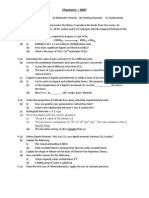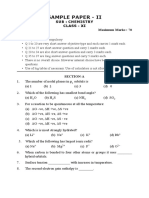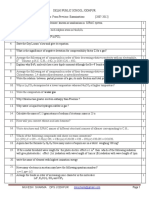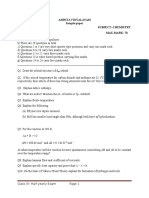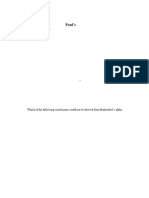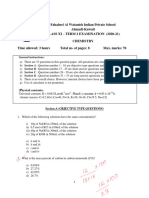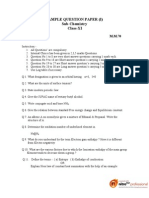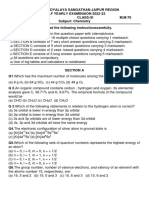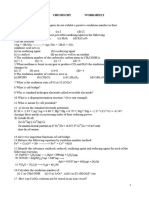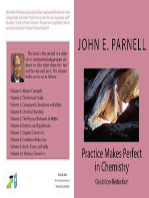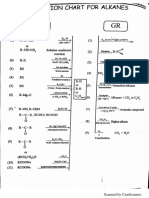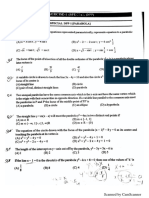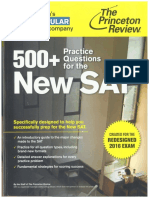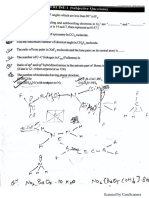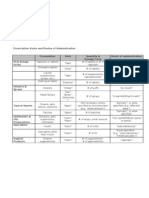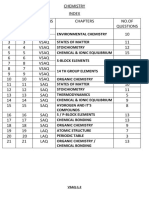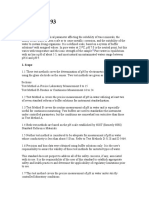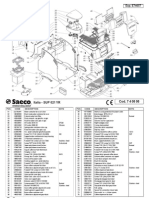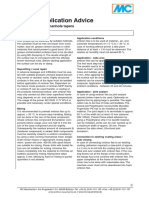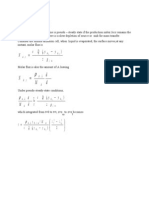Chemistry: Delhi Public School Ruby Park, Kolkata Class - XI
Chemistry: Delhi Public School Ruby Park, Kolkata Class - XI
Uploaded by
Ab CdCopyright:
Available Formats
Chemistry: Delhi Public School Ruby Park, Kolkata Class - XI
Chemistry: Delhi Public School Ruby Park, Kolkata Class - XI
Uploaded by
Ab CdOriginal Description:
Original Title
Copyright
Available Formats
Share this document
Did you find this document useful?
Is this content inappropriate?
Copyright:
Available Formats
Chemistry: Delhi Public School Ruby Park, Kolkata Class - XI
Chemistry: Delhi Public School Ruby Park, Kolkata Class - XI
Uploaded by
Ab CdCopyright:
Available Formats
DELHI PUBLIC SCHOOL RUBY PARK, KOLKATA
Class –XI
CHEMISTRY
1. State law of definite proportion.
2. What is the maximum number of electrons that can be present in an atom in which the highest principal quantum
number is 4 ?
3. What is compressibility factor ?
4. Write the expression for KP for the reaction :
3Fe (s) + 4H2O (g) Fe3O4 (s) + 4H2(g)
5. On the basis of molecular orbital theory, what is the similarity between F2 and O22- ?
6. Calculate the momentum of a particle which has a de Broglie wavelength of 0.1 nm.
7. (a) Name the species that will be isoelectronic with Rb+.
(b) Would you expect the first ionisation enthalpies of two isotopes of the same element to be same or different ?
Justify your answer.
8. 3.7 g of a gas at 250C occupied the same volume that 0.184 g of hydrogen at 170C and the same pressure.What is the
molecular weight of the gas ?
9. (a) What does the equilibrium constant K< 1 indicate ?
(b) What happens to a reversible reaction if a catalyst is added to it ?
10. (a) State Hess’s Law.
(b) Under what condition ∆H becomes equal to ∆U ?
11. (a)What is the difference between an isothermal and adiabatic process ?
(b)Giving suitable reason , predict the sign of entropy change for the following :
NH4NO3 (s) → N2O (g) + 2H2O (g)
12. In Ostwald’s process for the manufacture of nitric acid ,the first step involves the oxidation of ammonia gas by oxygen
gas to give nitric oxide gas and steam. What is the maximum weight of nitric oxide that can be obtained starting only
with 10.0 g of ammonia and 20.0 g of oxygen ?
13. (a) Assign the position of the element having outer electronic configuration, (n-2)f7(n-1)d1ns2.
(b) Distinguish between electronegativity and electron gain enthalpy.
(c) Arrange the following ions in order of decreasing size : Mg2+, S2-, Be2+, Cl- , Na+.
14. (a)Explain the following :
(i) Ionization enthalpy of Be is more than that of B.
(ii) Halogens have very high negative electron gain enthalpies.
(b)Arrange the following elements in order of increasing non-metallic character : N ,P ,O ,S.
15. (a) Interpret the non-linear shape of H2S and non-planar shape of PCl5 using VSEPR theory.
(b) Which one of NF3 and NH3 is more polar and why ?
16. (a) Differentiate between sigma and pi bond.
(b) Why is H2O a liquid but H2S a gas?
17. (a) State Pauli’s exclusion principle.
(b) What are the possible values of principal (n) and azimuthal (l) quantum numbers for the unpaired electrons in the
atom of an element whose atomic number is 17 ?
(a) State Hund’s rule of maximum mulplicity.
(b) Which one Fe2+ or Fe3+ is more paramagnetic and why?
18. 1.4 g nitrogen and 1.6 g oxygen are put in a 2litre flask at 270C.Calculate partial pressure of each gas, the total
pressure of the mixture and the composition of the mixture in mole percentage.
19. (a) State Charles’ law.
(b) Plot the graph PV vs P at constant temperature.
(c)Arrange the following gases in the decreasing order of magnitude of ‘a’: H2 ,CH4 ,O2.
20. Calculate the heat of combustion of glucose from the following data:
C (graphite) + O2 (g) → CO2 (g) ∆H = -395.0 kJ / mol
H2 (g) + ½ O2 (g) → H2O (l) ∆H = -269.4 kJ / mol
6C (graphite) + 6H2 (g) + 3O2 (g) → C6H12O 6 (s) ∆H = -1169.8 kJ/ mol
21. For the reaction Ag2O(s) → 2Ag + 1/2 O2 ; ∆H = -30.56 kJ / mol and ∆S = 6.66 J/ K/ mol.
Calculate the temperature at which ∆G is equal to zero. Also predict the direction of the reaction at
(i) this temperature and (ii) below this temperature.
22. What is the equilibrium concentration of each of the substance in the equilibrium when the initial concentration of ICl
was 0.78 M ?
2ICl (g) I2 (g) + Cl2 (g) , KC = 0.14
23. (a) State Le Chatelier’s principle.
(b) Using this principle predict the effect of (i) reducing the volume and (ii) decreasing the temperature on the
following system :
2CO (g) + O2 (g) 2CO2 (g) ∆𝐻 = -ve
24. (a) Calculate the mass of CuSO4 and number of sulphate ions present in 100 mL 0.01M CuSO4 solution .
(At wt of Cu = 63.5)
(b) DNA is thought to be a chemical compound responsible for heredity. Calculate the average volume occupied
by one molecule of DNA if its density is 1.1 g / mL and its molecular weight is 6 x 103 g / mol.
25. (a) Explain the following :
(i) CO2 and SO2 are not isostructural. (ii) O2- is paramagnetic but O2- is not.
(b) Which compound from each of the following pairs is more covalent ?
(i) PbCl2 or PbCl4 (ii) AgCl or AgI
(c) Draw the resonating structures of CO2.
26. (a)Assign reason for the following :
(i) B2 is paramagnetic while C2 is not. (ii) NH3 is soluble in water while PH3 is not.
(b) From each of the following pairs ,select the molecule with higher value of the property mentioned :
(i) NH3, PH3 (bond angle) (ii) HCl , HBr (ionic character)
(c) Represent diagrammatically the bond moments and the resultant dipole moments in SO 2.
27. (a) What is common between dxy and dx2-y2 orbitals ? What is the difference between them ?
(b)What is the angle between the lobes of the above two orbitals ?
(c)A near ultra violet photon of wavelength 300 nm is absorbed by a gas and then remitted as two photons. One photon
is of red light with wavelength 760nm.What would be wavelength of the second photon ?
28. Calculate the change in free energy when 1 mole of an ideal gas is compressed from 10 L to 1 L at 27 0C.
29. How many hydrogen and oxygen atoms are present in a spherical drop of water of radius 1 mm at 40C?
(density of water = 1 g/cc)
30. a) Write increasing order of C-C bond length and bond strength of the following molecules:-
Ethane, ethane, ethyne.
(b)Ethanol and dimethyl ether have the same molecular formula, but the boiling point of ethanol is greater
than dimethyl ether.
31.(a) Silver forms fcc lattice. X- ray studies of its crystals show that the edge length of its unit cell is 410 pm.
Calculate the density of silver (Atomic mass = 107.9 u)
(b)What type of defect is produced when NaCl is doped with MgCl2
(c)What is the effect of temperature on the electrical conduction of metallic conductors?
32. (i)Identify the defect shown in the diagram.
(ii)Is it a stoichiometric or non-stoichiometric defect?
(iii)How is the conductivity of a solid affected by this
defect?
(iv)Name a solid which shows this type of defect.
33.Explain Why:-
(a) ZnO acquires yellow colour on heating
(b) Silicon is an insulator but behaves as semiconductor when doped with Phosphorus.
34. An element crystallises in bcc.lattice with cell edge of 500pm. The density of the element is 7.5g/cc.
How many atoms are present in 300g of the element?
35. (i) Silver crystallises in a face centred cubic unit cell. Each side of the unit cell has a length of 409 pm. What is the
radius of an atom of silver ?.
(ii) Sodium crystallises in b.c.c. unit cell. Calculate the approximate number of unit cells in 9.2 g of sodium
(atomic mass of Na = 23 u).
You might also like
- 2111testing SingleDocument21 pages2111testing SingledurgeshtripatheeNo ratings yet
- Wa0010.Document32 pagesWa0010.Tanvi GuptaNo ratings yet
- Chemistry, BT-2, SET-IDocument6 pagesChemistry, BT-2, SET-ISoham NagNo ratings yet
- 11 Chemistry PDFDocument9 pages11 Chemistry PDFkumar shivamNo ratings yet
- REVISION CLASS XI SSE 2024 ImpDocument7 pagesREVISION CLASS XI SSE 2024 Impshuklaanmol1997No ratings yet
- 11 Sample Papers Chemistry 2020 English Medium Set 4Document5 pages11 Sample Papers Chemistry 2020 English Medium Set 4mehtamanjil1508No ratings yet
- ChemistryDocument6 pagesChemistrysanketjha491No ratings yet
- 2021 Class 11 Chemistry Solved Sample Paper Set 1Document5 pages2021 Class 11 Chemistry Solved Sample Paper Set 1Rais mirzaNo ratings yet
- GT Group of Institutions CHEMISTRY-Revision Worksheet Class 11 Chemistry Worksheet 12/02/2021Document6 pagesGT Group of Institutions CHEMISTRY-Revision Worksheet Class 11 Chemistry Worksheet 12/02/2021jayashree krishnaNo ratings yet
- Class Xi - Chemistry - Annual Exam - Set II - Sample Paper (2023-24)Document5 pagesClass Xi - Chemistry - Annual Exam - Set II - Sample Paper (2023-24)sanketjha491No ratings yet
- Sample Paper - Iii: General InstructionsDocument5 pagesSample Paper - Iii: General Instructionssuchetha manjunthaNo ratings yet
- Previous Year Paper 22023-24Document7 pagesPrevious Year Paper 22023-24ariasinghhh07No ratings yet
- Grade 11 Chemistry Subjective Mock TestDocument5 pagesGrade 11 Chemistry Subjective Mock TestMehak ShireenNo ratings yet
- Chemistry Five YearDocument9 pagesChemistry Five YeararslsaadNo ratings yet
- Class XI Chem Practice AnnualDocument6 pagesClass XI Chem Practice AnnualYash PachatNo ratings yet
- Class Xi Chemistry See Re Exam Qp 2023-24Document28 pagesClass Xi Chemistry See Re Exam Qp 2023-24swastikprasaddasNo ratings yet
- 11 Sample Papers Chemistry 1Document5 pages11 Sample Papers Chemistry 1Abhipsa Priyadarsini SahuNo ratings yet
- Previous Year QuestionsDocument19 pagesPrevious Year Questionsaleena'No ratings yet
- Compartment 2 Chem QPDocument5 pagesCompartment 2 Chem QPAAKASH BHATTNo ratings yet
- Sample Paper For Cumulative Examination Class-XI Subject - Chemistry Time Allowed: 3 Hrs. M.M.70Document4 pagesSample Paper For Cumulative Examination Class-XI Subject - Chemistry Time Allowed: 3 Hrs. M.M.70phultushiblsNo ratings yet
- Important Questions of Chemistry Xi Year Chapter#1Document6 pagesImportant Questions of Chemistry Xi Year Chapter#1Hero VinesNo ratings yet
- ACFrOgAOdxtfU2lvVvwZiIR8A1Ifnp8emPsux1s1t1 ExTiU VgvdiV3vIdeHoC6JgEqDn4PAkrJIgqlXHc Y BpG9D3ATSmLXDPPUrMVd3psrs LjDBNQ86tdzIp 0Document21 pagesACFrOgAOdxtfU2lvVvwZiIR8A1Ifnp8emPsux1s1t1 ExTiU VgvdiV3vIdeHoC6JgEqDn4PAkrJIgqlXHc Y BpG9D3ATSmLXDPPUrMVd3psrs LjDBNQ86tdzIp 0KarthikNo ratings yet
- Sample PaperDocument3 pagesSample Paperaparna patwalNo ratings yet
- Exam Review 2012 (4)Document5 pagesExam Review 2012 (4)jprax2007No ratings yet
- Iit Physic Question PapersDocument18 pagesIit Physic Question PapersSunil PandeyNo ratings yet
- Sample PaperDocument4 pagesSample PaperHariom SharmaNo ratings yet
- TT 11566Document14 pagesTT 11566arnavkashyap2008No ratings yet
- Class Xi Holiday Assignment PDFDocument6 pagesClass Xi Holiday Assignment PDF1234567No ratings yet
- Class 11 CHEMISTRY - Term2 Exam Question Paper (1) - 2020-21 2Document8 pagesClass 11 CHEMISTRY - Term2 Exam Question Paper (1) - 2020-21 2moiiifitbituserNo ratings yet
- 11 Chemistry FinalDocument5 pages11 Chemistry FinalDK KiskuNo ratings yet
- Chem Halfyrly 2020Document6 pagesChem Halfyrly 2020ShraddhaNo ratings yet
- West Bengal Board Class 10 Physical Science 2017 Question PaperDocument7 pagesWest Bengal Board Class 10 Physical Science 2017 Question Paperabhijr618No ratings yet
- Xi - ChemistryDocument4 pagesXi - Chemistrybinodxyz0No ratings yet
- Final Worksheet For Pre-Engineering StudentsDocument5 pagesFinal Worksheet For Pre-Engineering Studentshermela697No ratings yet
- Xi-Chem With Solution +1Document21 pagesXi-Chem With Solution +1Níkhíl Bansal100% (1)
- ASK14RIP112PT01 (O) General InstructionsDocument3 pagesASK14RIP112PT01 (O) General InstructionsSushil1998No ratings yet
- Sch3u Exam Review Ws s2018 PDFDocument4 pagesSch3u Exam Review Ws s2018 PDFwdsfNo ratings yet
- MCAT Review SilberbergDocument26 pagesMCAT Review SilberbergGuy La100% (1)
- Set-II QPDocument6 pagesSet-II QPrashi24022007No ratings yet
- class 11 chemistry question bankDocument8 pagesclass 11 chemistry question bankVishali NarayananNo ratings yet
- WORKSHEET XI CHEMISTRYDocument3 pagesWORKSHEET XI CHEMISTRYvineet20082No ratings yet
- Cbse Sample Paper For Class 11 ChemistryDocument11 pagesCbse Sample Paper For Class 11 ChemistryAshutosh RautNo ratings yet
- QP Chem - XI - 2019-20 11Document5 pagesQP Chem - XI - 2019-20 11Lawrence GaikwadNo ratings yet
- Xi Chemistry (Set-A) Final Term 2023-24 (110 Copies)Document7 pagesXi Chemistry (Set-A) Final Term 2023-24 (110 Copies)ayush.private.xxNo ratings yet
- Chemistry Sample Paper LS1Document3 pagesChemistry Sample Paper LS1surbhitaggarwalNo ratings yet
- Che 1Document18 pagesChe 1Krishna RNo ratings yet
- Modified Xi Chem Hy QP PaperDocument6 pagesModified Xi Chem Hy QP PaperxdhustlesNo ratings yet
- Chemistry-24Document4 pagesChemistry-24cfsharma2004No ratings yet
- physicsDocument11 pagesphysicsRamakrishnan RamakrishnanNo ratings yet
- CBSE Chemistry Class 11 (Mid Term Exam Model Paper)Document3 pagesCBSE Chemistry Class 11 (Mid Term Exam Model Paper)RounakNo ratings yet
- Half Yearly Sample Paper Class Xi ChemDocument6 pagesHalf Yearly Sample Paper Class Xi ChemAKASH KUMAR X ANo ratings yet
- Class - Xii Chemistry Sample Paper - 3 Time: Three Hours Max. Marks: 70 General InstructionsDocument17 pagesClass - Xii Chemistry Sample Paper - 3 Time: Three Hours Max. Marks: 70 General Instructionssoumya mazumdarNo ratings yet
- Xi Hy QP ChemDocument8 pagesXi Hy QP ChemYATHARTH VISHWAKARMANo ratings yet
- Nsec Mock Test-1Document26 pagesNsec Mock Test-1Mirthyunjay adithyaNo ratings yet
- Chemistry Sample Paper 2023-2024 XiDocument6 pagesChemistry Sample Paper 2023-2024 XiRandom UserNo ratings yet
- 11th ChemistryDocument18 pages11th ChemistryGaurav SarohaNo ratings yet
- Practice Makes Perfect in Chemistry: Oxidation-ReductionFrom EverandPractice Makes Perfect in Chemistry: Oxidation-ReductionRating: 5 out of 5 stars5/5 (1)
- Endohedral Metallofullerenes: Fullerenes with Metal InsideFrom EverandEndohedral Metallofullerenes: Fullerenes with Metal InsideNo ratings yet
- Practice Makes Perfect in Chemistry: Oxidation-Reduction with AnswersFrom EverandPractice Makes Perfect in Chemistry: Oxidation-Reduction with AnswersNo ratings yet
- Delhi Public School Ruby Park Assignment On Some Basic Concepts in ChemistryDocument1 pageDelhi Public School Ruby Park Assignment On Some Basic Concepts in ChemistryAb CdNo ratings yet
- AlkanesDocument36 pagesAlkanesAb CdNo ratings yet
- CurrentElectricityAndMagneticEffectsOfElectricCurr 1Document7 pagesCurrentElectricityAndMagneticEffectsOfElectricCurr 1Ab CdNo ratings yet
- Conic SectionsDocument42 pagesConic SectionsAb CdNo ratings yet
- 2020 - JEE Advanced Booster Test - 7 - SolutionsDocument14 pages2020 - JEE Advanced Booster Test - 7 - SolutionsAb CdNo ratings yet
- Alkanes 1Document12 pagesAlkanes 1Ab CdNo ratings yet
- Princeton Review 500+ Practice Questions For The New SATDocument103 pagesPrinceton Review 500+ Practice Questions For The New SATAb CdNo ratings yet
- Current Electricity by Aloke SirDocument20 pagesCurrent Electricity by Aloke SirAb CdNo ratings yet
- Chemical BondingDocument28 pagesChemical BondingAb CdNo ratings yet
- Solutions P-Block ElementsDocument29 pagesSolutions P-Block ElementsAb CdNo ratings yet
- Quench Embrittlement of Hardened 5160 Steel As A Function of Austenitizing TemperatureDocument10 pagesQuench Embrittlement of Hardened 5160 Steel As A Function of Austenitizing TemperaturejovaniNo ratings yet
- Chemical Health Risk Assessment (CHRA) - Draft Final PDFDocument31 pagesChemical Health Risk Assessment (CHRA) - Draft Final PDFPriyo Djatmiko100% (2)
- Resonance Adv Test Paper 1Document26 pagesResonance Adv Test Paper 1Avi AmbastNo ratings yet
- Prescription Verbs and Routes of AdminDocument2 pagesPrescription Verbs and Routes of AdminKingg AdjeiNo ratings yet
- Anees Xii Chem Mcqs 1Document29 pagesAnees Xii Chem Mcqs 1Majid AliNo ratings yet
- AiroxDocument5 pagesAiroxROBSON CardosoNo ratings yet
- Neopentane: Jump To Navigation Jump To SearchDocument5 pagesNeopentane: Jump To Navigation Jump To SearchGood GuyNo ratings yet
- (Brochure) Bell Less Top Charging G3 and PC Series Chute Transmission Gearbox enDocument6 pages(Brochure) Bell Less Top Charging G3 and PC Series Chute Transmission Gearbox enritesh kumar100% (1)
- Tarbuck Chapter 4 Weathering Soil and Mass WastingDocument8 pagesTarbuck Chapter 4 Weathering Soil and Mass WastingNicole SarileNo ratings yet
- Chemistry Previous PaperDocument14 pagesChemistry Previous PaperK Vishnu Vardhan ReddyNo ratings yet
- Mud BalanceDocument1 pageMud Balancelaxmi nandanNo ratings yet
- Antibacterial Activity of Azadirachita Indica and Psidium Guajava Extracts Against Three Bacterial Strains PDFDocument6 pagesAntibacterial Activity of Azadirachita Indica and Psidium Guajava Extracts Against Three Bacterial Strains PDFAlexander DeckerNo ratings yet
- Codex MilkDocument23 pagesCodex MilkFaizan TariqNo ratings yet
- Elbow Dimension PDFDocument2 pagesElbow Dimension PDFquang kinhluanengineeringNo ratings yet
- Astm D1293Document2 pagesAstm D1293Sylab InstrumentsNo ratings yet
- Saeco Incanto Sup021yrDocument4 pagesSaeco Incanto Sup021yrAndrzej Borowy100% (1)
- Cocaine Synthesis Shing Org Lett 2011Document4 pagesCocaine Synthesis Shing Org Lett 2011Cody DunnNo ratings yet
- Evaluation of Adhesive Anchors in Concrete Under Sustained Loading ConditionsDocument18 pagesEvaluation of Adhesive Anchors in Concrete Under Sustained Loading ConditionsWaleed AhmedNo ratings yet
- LecaDocument20 pagesLecav_sujeevan1546No ratings yet
- UntitledDocument39 pagesUntitledavinash goswamiNo ratings yet
- Flexible Coating For Manhole Tapers GAADocument2 pagesFlexible Coating For Manhole Tapers GAASlagalicaSlagalicaNo ratings yet
- PWHT PDFDocument118 pagesPWHT PDFErick Hogan100% (1)
- PKI - AN - 2018 - Analysis of Plant Materials For Toxic and Nutritional Elements With The NexION ICPMSDocument3 pagesPKI - AN - 2018 - Analysis of Plant Materials For Toxic and Nutritional Elements With The NexION ICPMSAdelitza StrubingerNo ratings yet
- QSB6.7 CM2350 B105-Rev2Document209 pagesQSB6.7 CM2350 B105-Rev2Kiril Angelov67% (3)
- Boiler: MaterialsDocument10 pagesBoiler: MaterialssarojpapuNo ratings yet
- Geotextile PresentationDocument75 pagesGeotextile Presentationrahul khanna100% (1)
- Term - 3, Paper - 2 - QaDocument26 pagesTerm - 3, Paper - 2 - Qaadars1695No ratings yet
- 2579-Article Text-7687-1-10-20190415Document8 pages2579-Article Text-7687-1-10-20190415Arshad Iqbal 383-FLL/BSURDU/S18No ratings yet
- Mass Transfer AssignmentDocument4 pagesMass Transfer AssignmentShanmugam GunasekaranNo ratings yet













